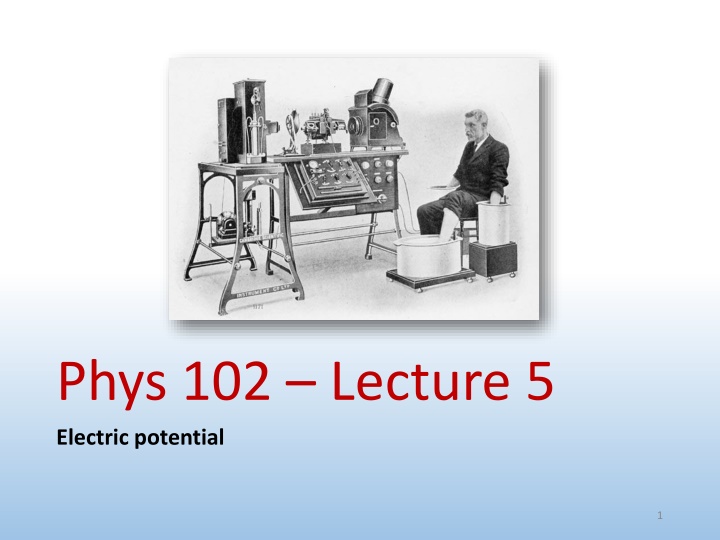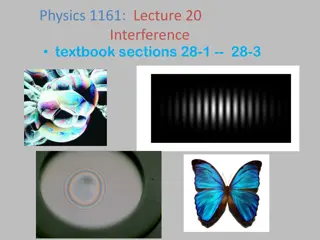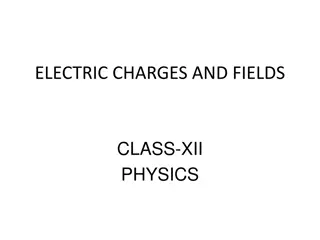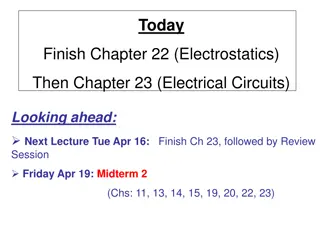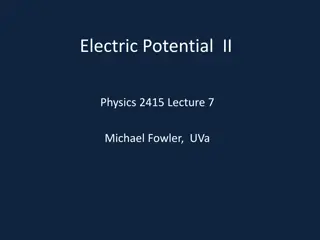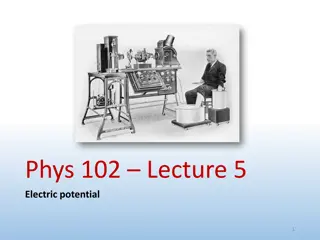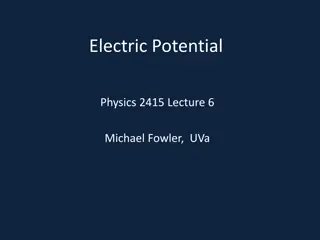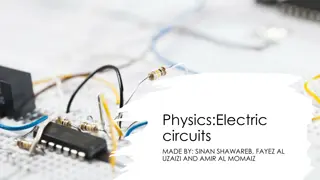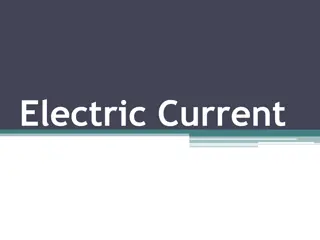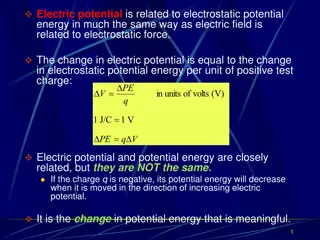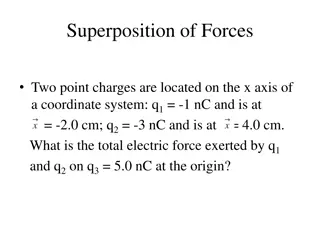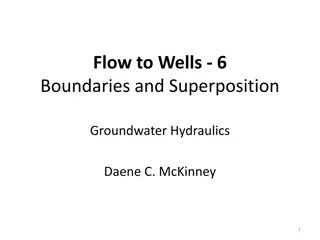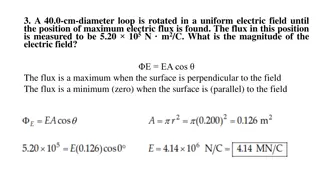Electric Potential and Superposition Principles
Learn about electric potential, superposition principle, equipotential lines, and their relation with electric field. Understand the scalar nature of electric potential, its calculation due to charges, and the concept of total potential in systems with multiple charges. Dive into practical applications like ECG and explore how to determine regions of zero electric potential. Visualize these concepts with examples and engage with activities to enhance your understanding of electric potential.
Download Presentation

Please find below an Image/Link to download the presentation.
The content on the website is provided AS IS for your information and personal use only. It may not be sold, licensed, or shared on other websites without obtaining consent from the author.If you encounter any issues during the download, it is possible that the publisher has removed the file from their server.
You are allowed to download the files provided on this website for personal or commercial use, subject to the condition that they are used lawfully. All files are the property of their respective owners.
The content on the website is provided AS IS for your information and personal use only. It may not be sold, licensed, or shared on other websites without obtaining consent from the author.
E N D
Presentation Transcript
Phys 102 Lecture 5 Electric potential 1
Today we will... Learn about the electric potential Use the principle of superposition Ex: point charges Represent electric potential with equipotential lines Relation with electric field Apply these concepts Ex: Electrocardiogram (ECG) Phys. 102, Lecture 3, Slide 2
Recall last time Gravitational potential energy Electric potential energy r + + h Height or altitude Electric potential Phys. 102, Lecture 3, Slide 3
The electric potential The electric potential is defined at a location in space around a charge or set of charges EPE of a charge q at position P U Electric potential at position P E V q Charge q Electric potential is 9 V higher at + end than end Units: J/C V ( volts ) + Electric potential is a scalar (a number) NOT a vector. Signs matter! Phys. 102, Lecture 3, Slide 4
Calculation: potential in H atom What is the magnitude of the electric potential due to the proton at the position of the electron? P + r = 0.53 x 10 10 m Phys. 102, Lecture 3, Slide 5
Superposition principle Total potential due to several charges = sum of individual potentials = V V tot Ex: what is the electric potential at point P due to q1, q2, and q3? P Simple addition, no vectors! Watch for signs, though! q1 + q3 + q2 = + + V V V V 1 2 3 tot Phys. 102, Lecture 3, Slide 6
Calculation: two charges Calculate the electric potential at point P due to charges q1 = +7 C and q2 = 3.5 C P 4 m q2 q1 3 m 3 m Phys. 102, Lecture 3, Slide 7
ACT: Electric potential Two charges +2Q and Q are placed on the x-axis. In which of the three regions I, II, or III on the x-axis can the electric potential be zero? I II III +2Q Q A. I B. II C. III D. None of the above Phys. 102, Lecture 3, Slide 8
Equipotential lines Devils tower, WY Topographical map 1. Altitude is constant at every point on this line 2. High (low) value = uphill (downhill) 3. Dense lines = steeper ascent or descent Gravitational potential energy Electric potential energy Height or altitude Electric potential Phys. 102, Lecture 3, Slide 9
Electric potential for a charge Equipotential lines represent electric potential in space graphically kq r = V 1. Electric potential is constant at every point on equipotential line 1V + Point charge 2 3 2. High (low) potential = uphill ( downhill ) 4 + 3. Dense lines = steeper ascent or descent Phys. 102, Lecture 3, Slide 10
Equipotential & electric field lines Equipotentials & electric field lines are geometrically related 1. Electric field points downhill , perpendicular to equipotential lines + 1V 2 3 4 + 2. Dense equipotential lines = large E field 3. Positive charge moves downhill Negative charge moves uphill Phys. 102, Lecture 3, Slide 11
Electric potential for a dipole + 150 100 + 50 0 0 50 100 150 DEMO Phys. 102, Lecture 3, Slide 12
ACT: Uniform electric field Which diagram best represents the equipotential lines corresponding to a uniform E field pointing to the right? E A. B. C. 1 2 3 4 1 2 3 4 5 V 5 V 5 4 3 2 1 V Phys. 102, Lecture 3, Slide 13
Lect. 4 Checkpoint 1.2 (Revisited) C E A B When a negative charge is moved from A to C, it moves along an equipotential line A. positive work B. zero work C. negative work Phys. 102, Lecture 3, Slide 14
ACT: Electric field gradient Now consider an E field that decreases going to the right. Which diagram best represents the equipotential lines? E Large Small A. B. C. Phys. 102, Lecture 3, Slide 15
ACT: CheckPoint 2.1 Points A and B lie in an ideal conductor inside a uniform E field C E A B The electric potential at point A is _____ at point B A. Greater than B. Equal to C. Less than Phys. 102, Lecture 3, Slide 16
Electric potential difference Note that the electric field and force depend on electric potential difference V, NOT on electric potential V itself E 5 Large 5 4 4 1 V 3 3 = E 0 2 2 1 V 1 V E Small E Constant This will be important starting next lecture with circuits Phys. 102, Lecture 3, Slide 17
Electric potential in biology Ion channels in cell membrane create a charge imbalance Cells have an electric potential difference across membrane Cells at rest are polarized Voutside > 0 Vinside < 0 Some cell types (ex: neurons and muscle cells) depolarize when they fire Voutside < 0 Vinside > 0 Phys. 102, Lecture 3, Slide 18
Electrocardiogram (ECG) ECG detects electric potential difference from depolarization and polarization of cardiac tissue + + + + V2 V1 + + + + + + Atrial depolarization Septal depolarization Ventricular depol. V1 V2 The heart behaves as time-varying electric dipole Phys. 102, Lecture 3, Slide 19
ACT: Electrocardiogram At a certain time during an ECG you measure a negative electric potential difference V2 V1. Which diagram of the cardiac dipole could be correct? A. B. C. V1 V2 V1 V1 V2 V2 Phys. 102, Lecture 3, Slide 20
Relationship between F, E, UE, V Vector Number ( scalar ) F UE [N] [J] q q 1 2 q q r = = 1 2 2 r F k U k Ex: Ex: F r = = cos W E U E V U q E F q E V [J/C]=[V] E [N/C]=[V/m] q q E points from high to low V = = E kr V kr Ex: Ex: 2 Phys. 102, Lecture 3, Slide 21
Summary of todays lecture Electric potential Superposition & point charges Equipotential lines Relationship with electric field Ex: Uniform field, non-uniform field, conductor, ECG kq r = V tot Phys. 102, Lecture 3, Slide 22
